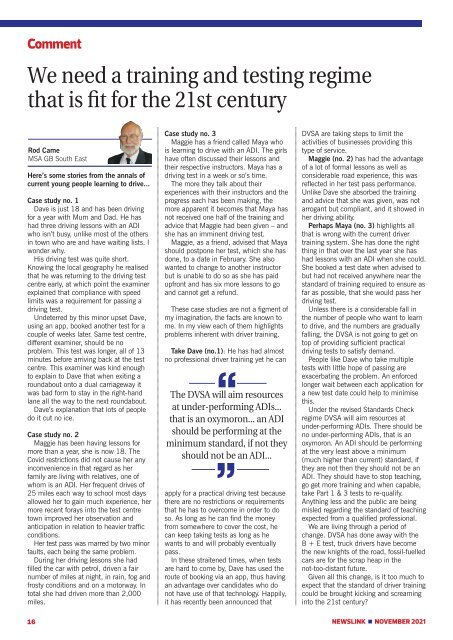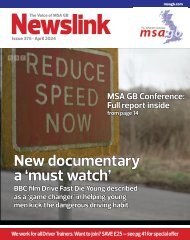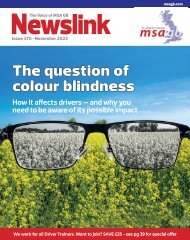MSA Newslink November 2021
Motor Schools Association, driver training and testing, road safety
Motor Schools Association, driver training and testing, road safety
You also want an ePaper? Increase the reach of your titles
YUMPU automatically turns print PDFs into web optimized ePapers that Google loves.
Comment<br />
We need a training and testing regime<br />
that is fit for the 21st century<br />
Rod Came<br />
<strong>MSA</strong> GB South East<br />
Here’s some stories from the annals of<br />
current young people learning to drive...<br />
Case study no. 1<br />
Dave is just 18 and has been driving<br />
for a year with Mum and Dad. He has<br />
had three driving lessons with an ADI<br />
who isn’t busy, unlike most of the others<br />
in town who are and have waiting lists. I<br />
wonder why.<br />
His driving test was quite short.<br />
Knowing the local geography he realised<br />
that he was returning to the driving test<br />
centre early, at which point the examiner<br />
explained that compliance with speed<br />
limits was a requirement for passing a<br />
driving test.<br />
Undeterred by this minor upset Dave,<br />
using an app, booked another test for a<br />
couple of weeks later. Same test centre,<br />
different examiner, should be no<br />
problem. This test was longer, all of 13<br />
minutes before arriving back at the test<br />
centre. This examiner was kind enough<br />
to explain to Dave that when exiting a<br />
roundabout onto a dual carriageway it<br />
was bad form to stay in the right-hand<br />
lane all the way to the next roundabout.<br />
Dave’s explanation that lots of people<br />
do it cut no ice.<br />
Case study no. 2<br />
Maggie has been having lessons for<br />
more than a year, she is now 18. The<br />
Covid restrictions did not cause her any<br />
inconvenience in that regard as her<br />
family are living with relatives, one of<br />
whom is an ADI. Her frequent drives of<br />
25 miles each way to school most days<br />
allowed her to gain much experience, her<br />
more recent forays into the test centre<br />
town improved her observation and<br />
anticipation in relation to heavier traffic<br />
conditions.<br />
Her test pass was marred by two minor<br />
faults, each being the same problem.<br />
During her driving lessons she had<br />
filled the car with petrol, driven a fair<br />
number of miles at night, in rain, fog and<br />
frosty conditions and on a motorway. In<br />
total she had driven more than 2,000<br />
miles.<br />
Case study no. 3<br />
Maggie has a friend called Maya who<br />
is learning to drive with an ADI. The girls<br />
have often discussed their lessons and<br />
their respective instructors. Maya has a<br />
driving test in a week or so’s time.<br />
The more they talk about their<br />
experiences with their instructors and the<br />
progress each has been making, the<br />
more apparent it becomes that Maya has<br />
not received one half of the training and<br />
advice that Maggie had been given – and<br />
she has an imminent driving test.<br />
Maggie, as a friend, advised that Maya<br />
should postpone her test, which she has<br />
done, to a date in February. She also<br />
wanted to change to another instructor<br />
but is unable to do so as she has paid<br />
upfront and has six more lessons to go<br />
and cannot get a refund.<br />
These case studies are not a figment of<br />
my imagination, the facts are known to<br />
me. In my view each of them highlights<br />
problems inherent with driver training.<br />
Take Dave (no.1): He has had almost<br />
no professional driver training yet he can<br />
‘‘<br />
The DVSA will aim resources<br />
at under-performing ADIs...<br />
that is an oxymoron... an ADI<br />
should be performing at the<br />
minimum standard, if not they<br />
should not be an ADI...<br />
‘‘<br />
apply for a practical driving test because<br />
there are no restrictions or requirements<br />
that he has to overcome in order to do<br />
so. As long as he can find the money<br />
from somewhere to cover the cost, he<br />
can keep taking tests as long as he<br />
wants to and will probably eventually<br />
pass.<br />
In these straitened times, when tests<br />
are hard to come by, Dave has used the<br />
route of booking via an app, thus having<br />
an advantage over candidates who do<br />
not have use of that technology. Happily,<br />
it has recently been announced that<br />
DVSA are taking steps to limit the<br />
activities of businesses providing this<br />
type of service.<br />
Maggie (no. 2) has had the advantage<br />
of a lot of formal lessons as well as<br />
considerable road experience, this was<br />
reflected in her test pass performance.<br />
Unlike Dave she absorbed the training<br />
and advice that she was given, was not<br />
arrogant but compliant, and it showed in<br />
her driving ability.<br />
Perhaps Maya (no. 3) highlights all<br />
that is wrong with the current driver<br />
training system. She has done the right<br />
thing in that over the last year she has<br />
had lessons with an ADI when she could.<br />
She booked a test date when advised to<br />
but had not received anywhere near the<br />
standard of training required to ensure as<br />
far as possible, that she would pass her<br />
driving test.<br />
Unless there is a considerable fall in<br />
the number of people who want to learn<br />
to drive, and the numbers are gradually<br />
falling, the DVSA is not going to get on<br />
top of providing sufficient practical<br />
driving tests to satisfy demand.<br />
People like Dave who take multiple<br />
tests with little hope of passing are<br />
exacerbating the problem. An enforced<br />
longer wait between each application for<br />
a new test date could help to minimise<br />
this.<br />
Under the revised Standards Check<br />
regime DVSA will aim resources at<br />
under-performing ADIs. There should be<br />
no under-performing ADIs, that is an<br />
oxymoron. An ADI should be performing<br />
at the very least above a minimum<br />
(much higher than current) standard, if<br />
they are not then they should not be an<br />
ADI. They should have to stop teaching,<br />
go get more training and when capable,<br />
take Part 1 & 3 tests to re-qualify.<br />
Anything less and the public are being<br />
misled regarding the standard of teaching<br />
expected from a qualified professional.<br />
We are living through a period of<br />
change. DVSA has done away with the<br />
B + E test, truck drivers have become<br />
the new knights of the road, fossil-fuelled<br />
cars are for the scrap heap in the<br />
not-too-distant future.<br />
Given all this change, is it too much to<br />
expect that the standard of driver training<br />
could be brought kicking and screaming<br />
into the 21st century?<br />
16<br />
NEWSLINK n NOVEMBER <strong>2021</strong>

















